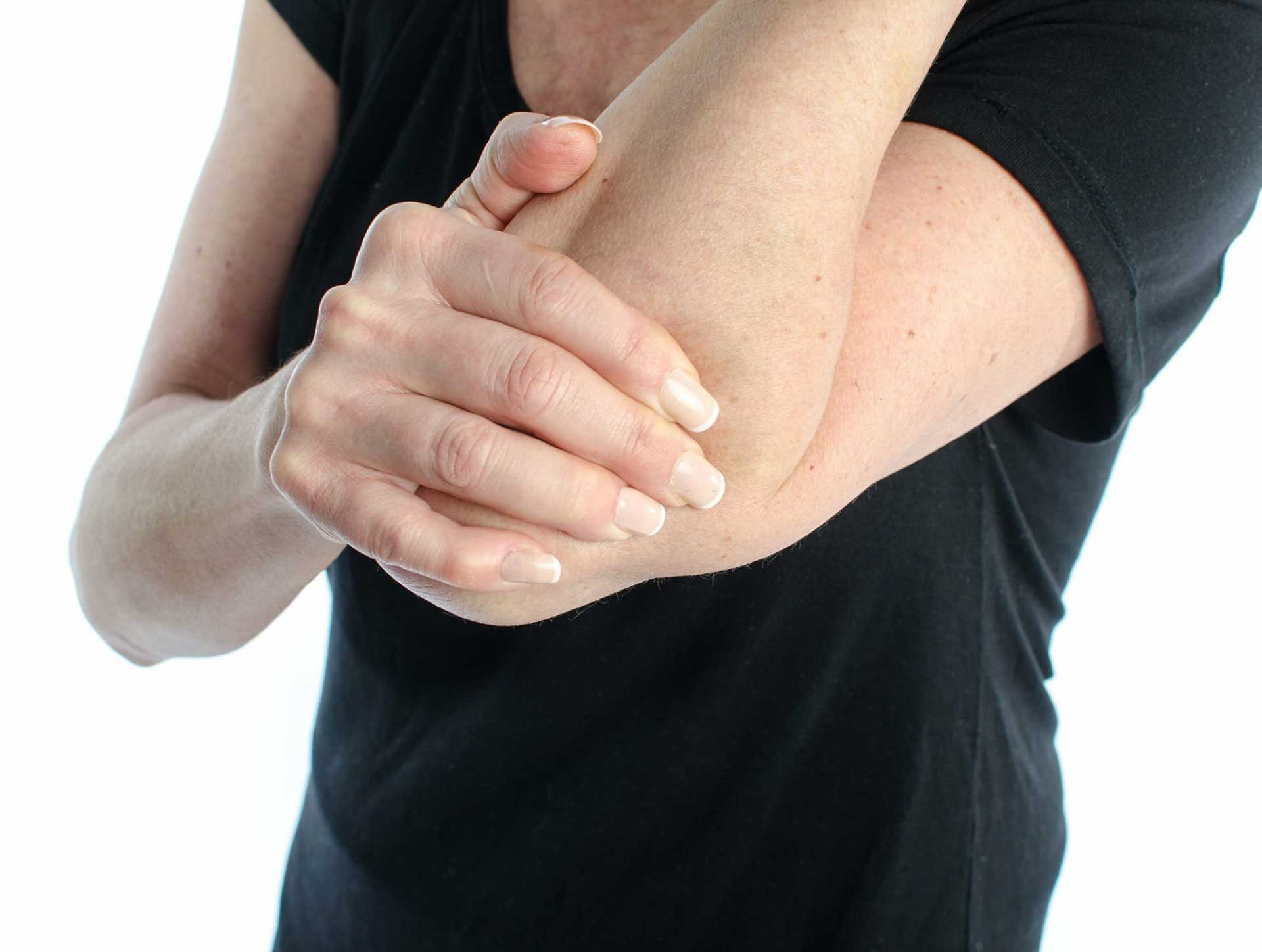
DECEMBER 20, 2023 | 3 Mins Read
TABLE OF CONTENTS
A hyperextended elbow can be a major setback, whether you're an athlete or someone who enjoys an active lifestyle. This guide offers an in-depth look at what it means to suffer from this injury and how to effectively navigate the road to recovery. We'll cover everything from the initial response to injury management and preventative measures, aiming to restore not just your elbow's function but also your quality of life.

A hyperextended elbow is a condition where the elbow joint is pushed past its normal range, resulting in overstretching or tearing of the ligaments. This injury is not only painful but can significantly hinder the arm's functionality. Ligaments, which connect bone to bone, play a crucial role in maintaining joint stability.
When these are overstretched or torn, it compromises the elbow's structural integrity, leading to discomfort, swelling, and a noticeable decrease in the joint's range of motion. Understanding this injury is pivotal, as it lays the foundation for a tailored and effective treatment plan.
Hyperextension injuries to the elbow are most commonly associated with sports and activities that put excessive strain on the arm. In sports like basketball and gymnastics, athletes often experience this injury during falls or sudden, forceful movements.
Weightlifting, especially when involving heavy weights or incorrect form, can also lead to hyperextension. Beyond the realm of sports, everyday activities, such as trying to break a fall with an outstretched hand, can unexpectedly cause the elbow to hyperextend.
Here are the primary symptoms to look out for:
When faced with a hyperextended elbow, swift and appropriate action is crucial to mitigate pain and expedite recovery. The initial hours following the injury are pivotal in determining the overall healing process. This section outlines the immediate steps you should take to treat a hyperextended elbow, emphasizing the importance of cold therapy, compression, rest, and elevation as fundamental components of early treatment.
Cold therapy stands as the primary and essential response to a hyperextended elbow. By applying ice to the injured area, you can effectively reduce swelling and alleviate pain, initiating the healing process.
Compression is a key element in the treatment of a hyperextended elbow, aiding significantly in reducing swelling and stabilizing the injured area.
Compression sleeves, in particular, offer uniform pressure around the elbow. They are advantageous due to their ease of use and minimal restriction of movement, unlike more cumbersome bandages. Compression works by limiting fluid accumulation around the elbow joint, supporting the injured tissues, easing pain, and helping to maintain mobility during the recovery process.
Rest plays a vital role in the healing of a hyperextended elbow, as it allows the body the necessary time to repair damaged ligaments and tissues.
The duration of rest needed varies based on the injury's severity. Mild cases may require rest for a few days to a week, while more severe injuries might necessitate several weeks of rest. It's essential to avoid activities that could further strain the elbow during this period to prevent exacerbating the injury.
Elevation is a crucial component in managing swelling and encouraging healing for a hyperextended elbow.
When resting or sitting, it's beneficial to use pillows or cushions to prop up the arm. Make sure the elbow is elevated above the level of your heart to effectively reduce blood flow to the injured area, which helps in minimizing swelling and pain. This position should be maintained as much as possible during the initial days following the injury.
In the journey to recovery from a hyperextended elbow, choosing the right type of support or heat retainer is as crucial as any other treatment step. The selection you make can significantly influence your comfort level and the effectiveness of the healing process. Understanding the different types of supports available and knowing when to incorporate heat retainers into your recovery regimen can make a notable difference in your healing trajectory.
The market offers a diverse array of elbow supports, tailored to suit various stages and severities of elbow injuries. At the basic end are compression sleeves, which provide support and compression, making them ideal for mild hyperextension injuries or for use during activities that could strain the elbow.
For more severe injuries, structured braces are more appropriate. These often feature adjustable straps and pads for a customized fit and targeted compression, offering a higher level of support. They stabilize the elbow joint and restrict movements that might exacerbate the injury. Some of these advanced braces also include hinges to control the elbow's range of motion, making them a suitable choice for athletes or individuals with recurring elbow issues.
Heat retainers emerge as an invaluable tool during the later stages of recovery from a hyperextended elbow, particularly as swelling decreases and stiffness becomes a more pronounced concern. By maintaining gentle warmth around the elbow, these retainers aid in increasing blood flow, thereby reducing stiffness and hastening tissue healing, which in turn improves joint mobility. Additionally, heat retainers offer therapeutic benefits like pain relief and muscle relaxation, making them especially beneficial when regaining movement in the elbow. However, it's crucial to use them only after the injury has moved past its acute phase to avoid inadvertently increasing swelling and delaying the recovery process.

Managing pain and inflammation is crucial in treating a hyperextended elbow. Over-the-counter anti-inflammatory drugs like ibuprofen or aspirin are effective in reducing pain and swelling. It's important to use these medications according to directions and consult a healthcare provider if the pain continues.
Additionally, once initial swelling subsides, pain relief can be augmented with gentle stretching exercises, massage, and heat therapy. These methods aid in restoring mobility, easing muscle tension, and promoting healing, offering a comprehensive approach to managing discomfort during recovery.
While initial home care is crucial in the treatment of a hyperextended elbow, there are scenarios where professional medical intervention becomes necessary. Seeking professional treatment can provide specialized care and ensure a more efficient recovery, especially in cases where home remedies are insufficient. Understanding when to seek this care and the types of therapies available is key to a successful recovery.
In cases of severe hyperextended elbow injuries, the path to recovery often necessitates advanced therapies and a carefully structured rehabilitation program. Such approaches are crucial for restoring full functionality and mitigating long-term impacts.
Electrotherapy, encompassing treatments like ultrasound and TENS (Transcutaneous Electrical Nerve Stimulation), plays a pivotal role in advanced therapy. Ultrasound therapy utilizes sound waves to stimulate the affected area, promoting tissue healing and reducing inflammation. TENS, on the other hand, employs mild electrical currents to alleviate pain. These methods are non-invasive and can significantly speed up the healing process by reducing pain and enhancing tissue repair.
A structured rehabilitation program is crucial for full recovery from a hyperextended elbow. This program should include exercises aimed at enhancing range of motion, strength, and flexibility, tailored to the individual's injury severity and overall health. Starting with gentle exercises and progressively increasing in intensity, the program ensures a steady healing process.
It may also integrate other treatments like heat or ice therapy, based on the recovery stage. The ultimate objective is to fully restore elbow functionality and prevent future injuries, with regular assessments by a physical therapist to monitor progress and adjust the regimen for the best results.
Preventing future hyperextensions and maintaining elbow health are crucial for long-term well-being.
Incorporate strengthening and flexibility exercises into your routine, use proper techniques in sports and physical activities, and wear protective gear when necessary.
Exercises such as wrist curls, reverse wrist curls, and tricep extensions can help strengthen the muscles around the elbow, providing better support and reducing the risk of re-injury.
Long-term care and regular check-ups are important for overall elbow health.
Regular visits to a healthcare provider can help monitor the condition of your elbow and prevent potential future issues.
The journey to recover from a hyperextended elbow is one that requires patience, appropriate treatment, and quality support. A product like the Koprez Elbow Compression Sleeve can be a game-changer in this journey, offering the necessary support and comfort. Check out this essential recovery aid on and take a step toward effective healing and prevention.
Author

Claire Evans worked as the content marketing manager at Koprez. Claire combined a background of writing and editing, marketing, and patient education to best serve consumers, fitness enthusiasts, athletes, and anyone who relies on the Koprez brand for helpful information.
Koprez® Featured Products